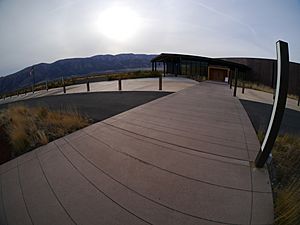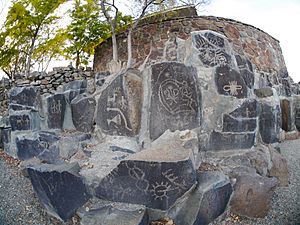Wanapum facts for kids
The Wanapum are a group of Native American people. They used to live along the Columbia River in what is now Washington state. Their homes were from above Priest Rapids down to where the Snake River joins the Columbia.
Today, about 60 Wanapum people still live near the Priest Rapids Dam. The name "Wanapum" comes from the Sahaptin word wánapam. This means "river people," because wána means "river" and -pam means "people." They are now part of the federally recognized Confederated Tribes and Bands of the Yakama Nation.
Contents
History of the Wanapum People
For a very long time, the Wanapum's land was a great place for salmon fishing. Salmon was a super important food source for them. We don't know much about the very first people who lived in this area. It's also unclear which tribes were there before the Wanapum settled.
The Wanapum built their homes from a plant called tule. They also carved more than 300 petroglyphs into the basalt cliffs. These are ancient rock carvings that tell stories or show important symbols.
Meeting Lewis and Clark
In 1805, the famous explorers Lewis and Clark met the Wanapum. The Wanapum were led by their chief, Cutssahnem. The tribe welcomed the explorers kindly. They shared food and entertainment with them. Captain Clark wrote in his journals about their homes, clothes, and how they looked.
The Washane Religion
In the 1800s, a new Native American religion began. It was called Washane, Washani, or the "Dreamer Religion." A spiritual leader of the Wanapum named Smohalla started it. People who followed this religion believed that if they stuck to their old traditions and rituals, white settlers would eventually leave. Instead of fighting, they focused on prayer.
Because of this religion, or for other reasons, the Wanapum never fought against white settlers. They also never signed a treaty with the United States government. This meant they didn't have any land rights that the government officially recognized.
Impact of the Dams
In 1953, two large dams were built on the Columbia River. These were the Priest Rapids Dam and the Wanapum Dam. When the dams were built, they flooded the riverbanks. This was where the Wanapum had lived in their traditional tule houses for many years.
Wanapum Heritage Today
Today, you can still see some of the Wanapum's ancient art. About 60 Wanapum petroglyphs were carefully removed from the rocks before the area was flooded. You can see these carvings at Ginkgo Petrified Forest State Park.
The Wanapum Heritage Center Museum shows many items from before the dams were built. These artifacts help us understand their traditional way of life. The Wanapum River Patrol also helps protect their ancestral lands. They watch over important places to make sure they are safe. They also share information with visitors who come to the area.
The Washane religion, started by Smohalla, is still practiced today. Some members of other tribes also follow its teachings.
See also
 In Spanish: Wanapum para niños
In Spanish: Wanapum para niños



